Affiliate links on Android Authority may earn us a commission. Learn more.
Samsung Galaxy S7 vs LG G5 vs the competition
Published onFebruary 22, 2016
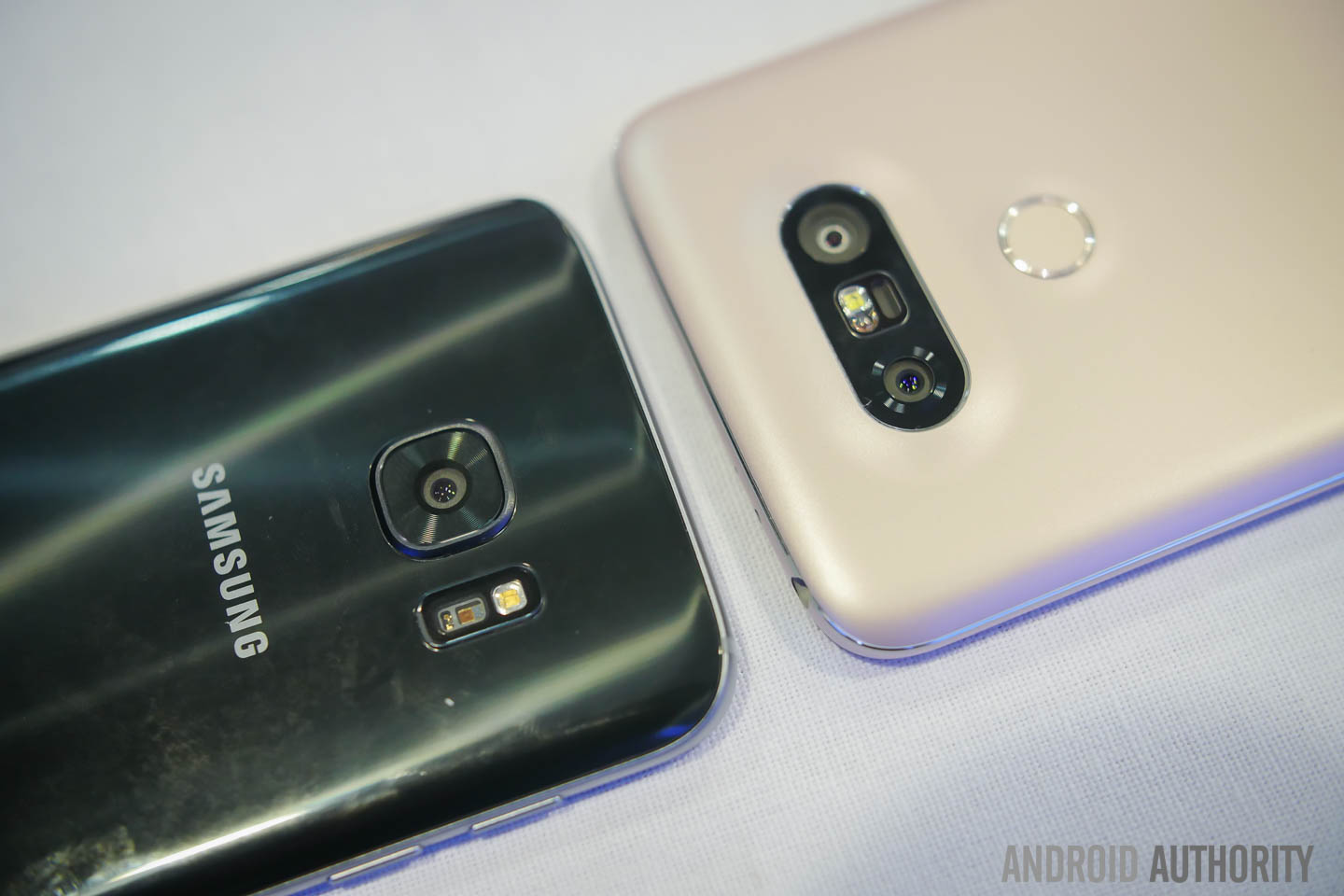
They’re here. The 2016 Android flagship seasons is now in full swing, with the unveiling of both the LG G5 and Samsung Galaxy S7 / S7 Edge over the weekend. There are cutting edge pieces of technology all around and some notable differences with last year’s leading smartphones. So let’s take a look at how some of the first 2016 flagships stack up against some of the best models from 2015.
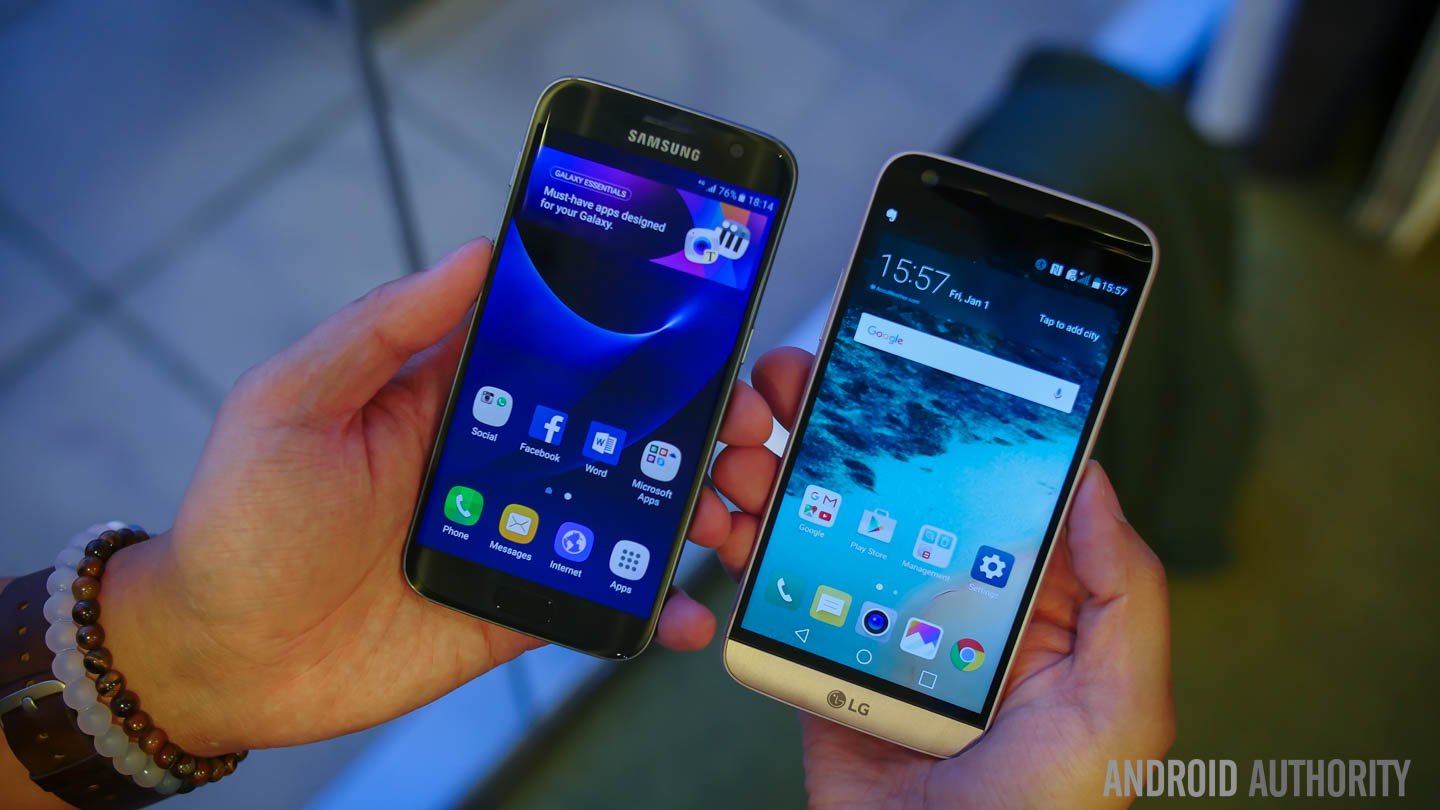
One of the instantly noticeable changes with the LG G5 is an almost completely redesigned handset. The plastics and even the rear volume rocker have been completely switched out in favour of a metal uni-body and LG’s very unique modular design. We’ll have to see how this plays out for the company, but it’s tough not to help but feel that LG is really trying to push the boat out. Samsung, on the other hand, has kept a very similar design between the Galaxy S6 and the S7, but the glass back and curved Edge display were already nice enough looking. Enough of that though, let’s delve into some specs.
[related_videos align=”center” type=”custom” videos=”675002,674813,674986,675004″]
| Samsung Galaxy S7 | LG G5 | Sony Xperia Z5 | LG V10 | Nexus 6P | |
|---|---|---|---|---|---|
Display | Samsung Galaxy S7 5.1 / 5.5-inch QHD AMOLED (2560x1400) | LG G5 5.3-inch QHD LCD (2560x1440) | Sony Xperia Z5 5.2-inch 1080p LCD (1920x1080) | LG V10 5.7-inch QHD LCD (2560x1440) | Nexus 6P 5.7-inch QHD AMOLED (2560x1440) |
SoC | Samsung Galaxy S7 Samsung Exynos 8890 or Qualcomm Snapdragon 820 | LG G5 Qualcomm Snapdragon 820 | Sony Xperia Z5 Qualcomm Snapdragon 810 | LG V10 Qualcomm Snapdragon 808 | Nexus 6P Qualcomm Snapdragon 810 |
CPU | Samsung Galaxy S7 4 x Samsung M1 + 4x Cortex-A53 or 4 x Kryo | LG G5 4 x Kryo | Sony Xperia Z5 4 x Cortex-A57 + 4 x Cortex-A53 | LG V10 2 x Cortex-A57 + 4 x Cortex-A53 | Nexus 6P 4 x Cortex-A57 + 4 x Cortex-A53 |
GPU | Samsung Galaxy S7 Mali-T880 MP12 or Adreno 530 | LG G5 Adreno 530 | Sony Xperia Z5 Adreno 430 | LG V10 Adreno 418 | Nexus 6P Adreno 430 |
SoC Process | Samsung Galaxy S7 14nm | LG G5 14nm | Sony Xperia Z5 20nm | LG V10 20nm | Nexus 6P 20nm |
RAM | Samsung Galaxy S7 4GB | LG G5 4GB | Sony Xperia Z5 3GB | LG V10 4GB | Nexus 6P 3GB |
Storage | Samsung Galaxy S7 32/64GB + 200GB microSD | LG G5 32GB + 2TB microSD | Sony Xperia Z5 32GB + 200GB microSD | LG V10 32/64GB + 200GB microSD | Nexus 6P 32/64/128GB |
2015 saw a number of manufacturers hop up to the QHD (2560×1440) display resolution and the Sony Xperia Z5 Premium even introduced the world’s first 4K smartphone display. Things haven’t moved on so much in early 2016, with both LG and Samsung opting to use similar, if not identical displays to last year’s flagships. This display clarity is no longer reserved for the very top tier either, with more cost effective smartphones from Motorola and ZTE offering competing resolutions. LG is again using its QHD LCD technology while Samsung continues to make use of AMOLED and neither has been making a big fuss about its latest panels, so we’re not looking a major increase in quality or clarity over other handsets on the market.
However, LG and Samsung are both changing things up quite a bit with an “Always-on” display. In the G5, this occupies the upper third of the screen. The time and other notifications can be displayed here quickly without eating up a huge amount of the battery, and it’s certainly a useful evolution over the LG V10’s secondary ticker display.
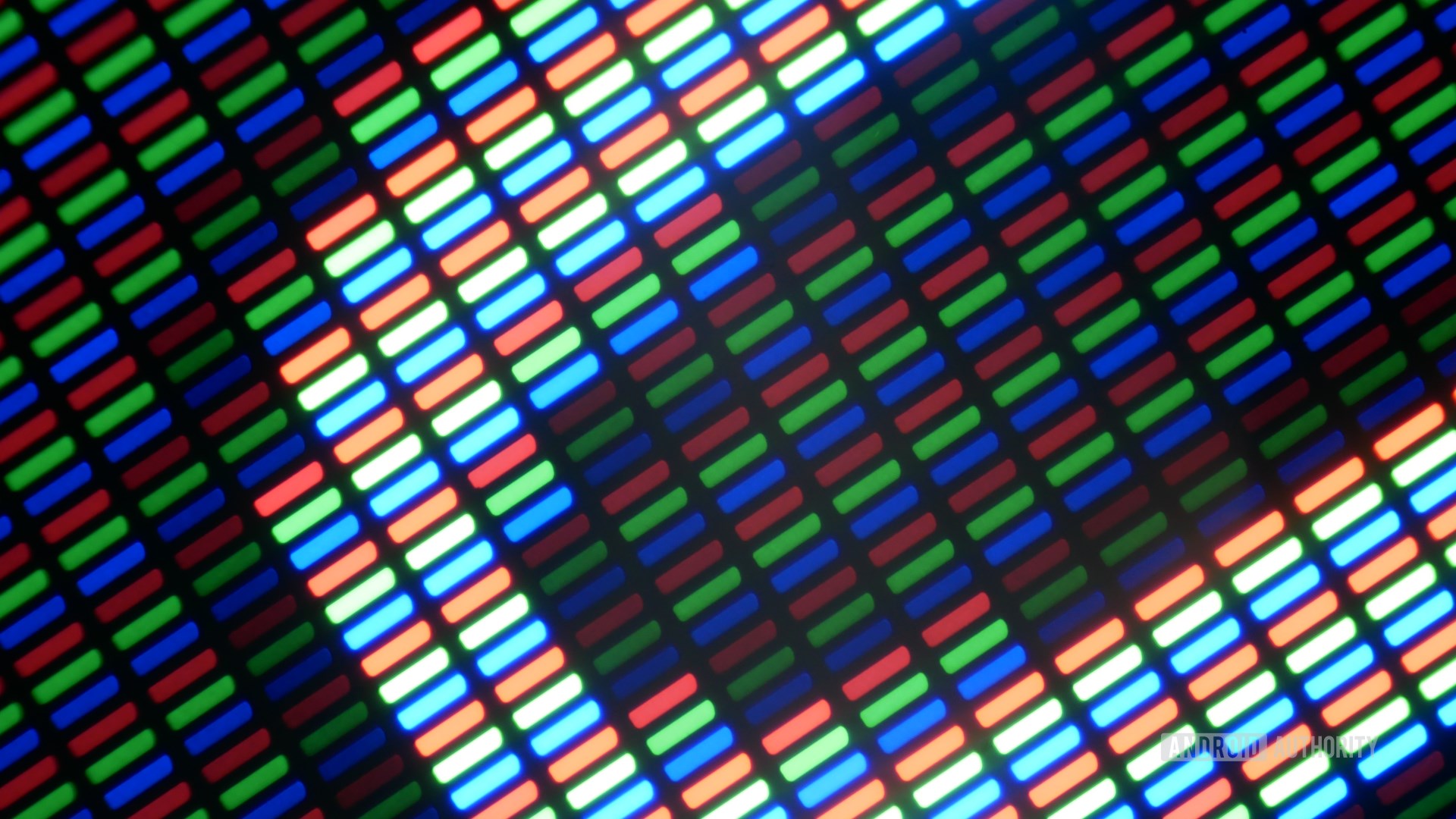
One of the big changes with the 2016 generation is the move on up to Qualcomm’s new Snapdragon 820 processor. Rather than the octa-core Snapdragon 810 from last year, the Snapdragon 820 moves down to a quad-core configuration based on Qualcomm’s latest Kyro CPU cores. The CPU boasts double the performance of Qualcomm’s older designs, in some situations, and the new Adreno 530 GPU promises a 40 percent boost to GPU performance. Not only is the chip looking to boost performance, but the move down to a 14nm manufacturing process is going to make it more energy efficient than last year’s phones too. This should provide a notable boost to performance over last year’s Snapdragon 810 and, especially for LG, a more noticeable jump in performance over the hexa-core Snapdragon 808 from the G4.
The LG G5 is making use of the Snapdragon 820 and US regional variants of the Galaxy S7 and S7 Edge are now confirmed to ship with it too. Interestingly, neither party is interesting in cramming even more RAM into their handsets, with both sticking at the top of the 3GB to 4GB consensus from last year. However, Samsung also has its Exynos 8890 SoC for the Galaxy S7 range as well.
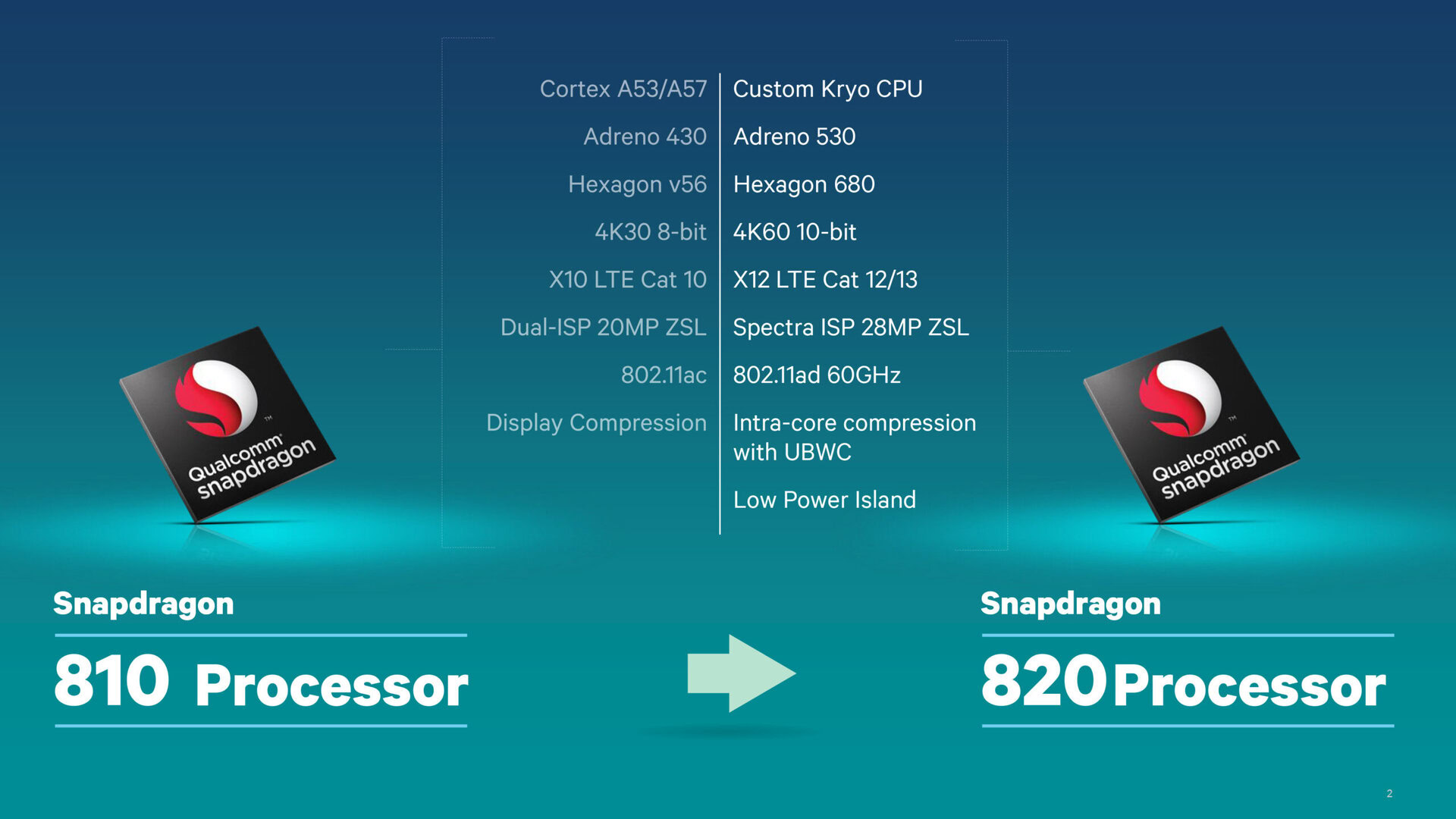
Rather than a quad-core chip, the Exynos 8890 features an octa-core big.LITTLE CPU design more reminiscent of last year’s Snapdragon 810 and Exynos 7420. However, this will be the first SoC to feature a custom designed CPU from Samsung, currently known as the M1, which promises to be 30 percent faster than Samsung’s last chip and the SoC is offering a 60 percent boost to overall system performance.
Furthermore, Samsung is really going all out on graphics and gaming performance, and is one of the first handsets to support the new Vulkan graphics API. Not only does the Exynos 8890 pack in 12 of the latest Mali-T880 GPU cores, up from eight Mali-T760 cores in the S6, but the company has developed a water cooling solution to help keep the CPU cool and running at maximum speeds under high-loads. Given the overheating reports from last year, this is a welcome attention to detail that should offer consumers a smoother experience than last year’s high-end phones.
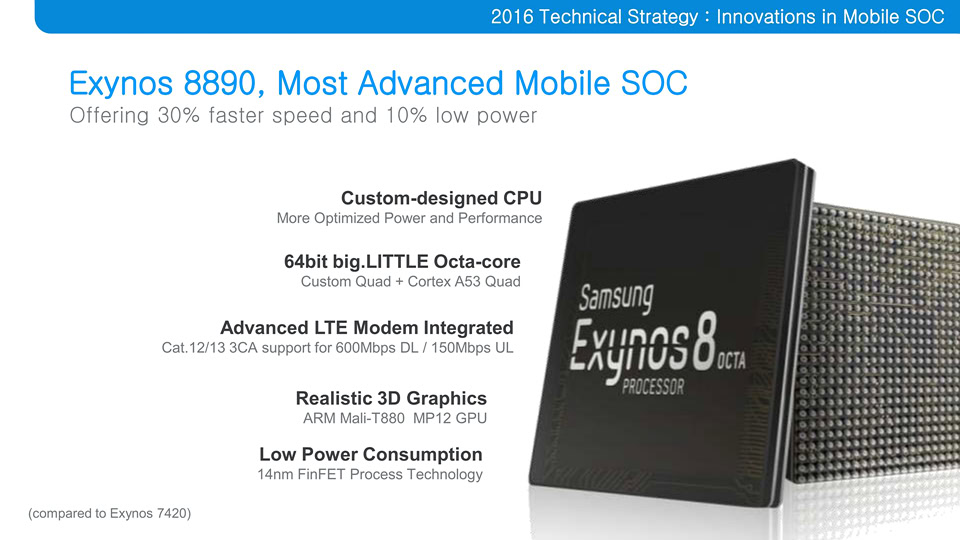
Another part of today’s high-end mobile SoCs is the inclusion of an integrated LTE modem. Both the Snapdragon 820 and Exynos 8890 features Category 12/13 LTE modems, offering support for LTE-Advanced carrier aggregation and faster download speeds, which can peak at 600Mbps download and 150Mbps upload if your carrier can keep up. Most 2015 models feature Category 9 LTE modems.
With all of this talk about extra processing power, it is perhaps not surprising that Samsung has opted for much larger battery capacities this time around. The company has upgraded the 2,550mAh battery in the Galaxy S6 to a 3,000mAh cell in the S7. The new Edge version moves from 2,600mah to 3,600mAh, putting Samsung’s handsets more in-line with what we have come to expect. LG, on the other hand, has made its battery smaller, going from 3,000mAh in the G4 to 2,800mAh in the G5, putting this flagship at the smaller end of the scale. Although, perhaps SoC power improvements can offset this slight loss in battery capacity.
| Samsung Galaxy S7 | LG G5 | Sony Xperia Z5 | LG V10 | Nexus 6P | |
|---|---|---|---|---|---|
Rear camera | Samsung Galaxy S7 12MP, F/1.7, 1.4µm pixels | LG G5 16MP (PDAF, OIS) + 8MP wide-angle lens | Sony Xperia Z5 23MP (PDAF), F/2.0 | LG V10 16MP (laser AF, OIS), F/1.8 | Nexus 6P 12.3MP (laser AF), F/2.0 |
Front camera | Samsung Galaxy S7 5MP, F/1.7 | LG G5 8MP | Sony Xperia Z5 5.1MP, F/2.4 | LG V10 Dual 5MP, F/2.2 | Nexus 6P 8MP, F/2.4 |
IP rating? | Samsung Galaxy S7 IP68 | LG G5 | Sony Xperia Z5 IP68 | LG V10 | Nexus 6P |
Fingerprint | Samsung Galaxy S7 Yes | LG G5 Yes | Sony Xperia Z5 Yes | LG V10 Yes | Nexus 6P Yes |
Modem | Samsung Galaxy S7 Cat 12/13 LTE 600Mbps DL, 150Mbps UL | LG G5 Cat 12/13 LTE 600Mbps DL, 150Mbps UL | Sony Xperia Z5 Cat 9 LTE 450 Mbps DL, 50Mbps UL | LG V10 Cat 9 LTE 450 Mbps DL, 50Mbps UL | Nexus 6P Cat 9 LTE 450 Mbps DL, 50Mbps UL |
Fast Charge | Samsung Galaxy S7 Yes | LG G5 Quick Charge 3.0 | Sony Xperia Z5 Quick Charge 2.0 | LG V10 Quick Charge 2.0 | Nexus 6P Quick Charge 2.0 |
Wireless Charge | Samsung Galaxy S7 Yes | LG G5 No | Sony Xperia Z5 No | LG V10 No | Nexus 6P No |
Battery | Samsung Galaxy S7 3,000mAh / 3,600mAh | LG G5 2,800mAh removable | Sony Xperia Z5 2,900mAh | LG V10 3,000mAh removable | Nexus 6P 3,450mAh |
Last year could probably have been dubbed year of the smartphone camera, with virtually every player showing notable improvements and some smaller manufacturers rising to the top. This year is no exception, with both LG and Samsung opting to do something different in 2016 in a bid to separate themselves from the competition.
2016 saw some excellent camera hardware from the likes of the Nexus 6P, helped in no small part by its much larger camera pixel sizes which can capture more light and improve performance in low light conditions. Samsung seems to agree with this direction, opting for just a 12 megapixel sensor in its Galaxy S7 and S7 Edge. However, the pixel sizes are 56 percent larger in the S7, up from 1.12µm to 1.4µm. Another point to note is that apertures have improved again this generation, with the Galaxy S7 reaching F/1.7.
Interestingly, HTCalso tried its hand at larger pixels with its Ultrapixel technology a couple of years back, but the results don’t appear to have been consistent.
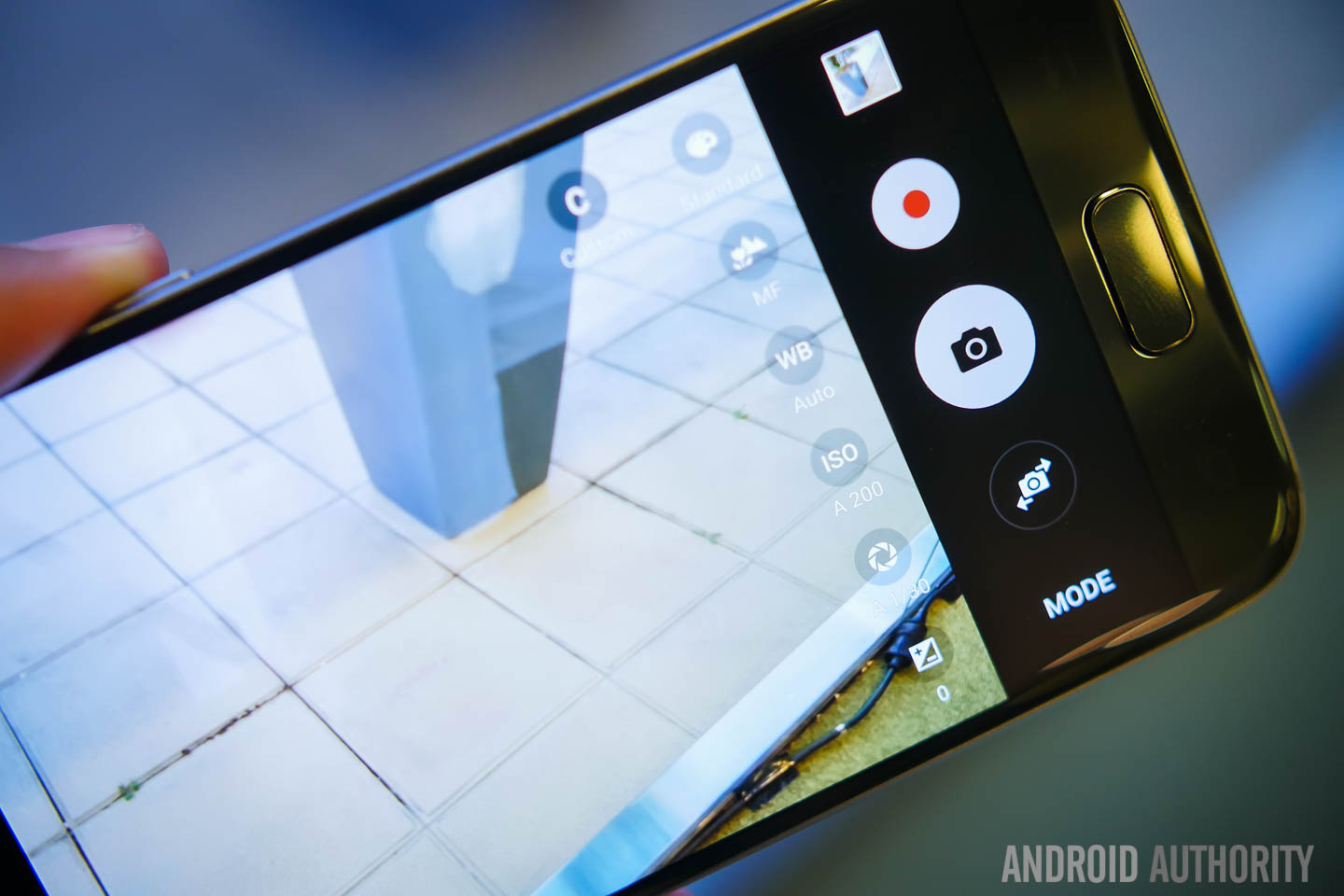
LG has instead opted for a dual rear camera configuration this time around, but has interestingly decided on two different sensor sizes. The main rear camera remains at 16 megapixels and is accompanied by a 8 megapixel sensor with a wide angled lens for 135 degree shots. Interestingly, LG also appears to have implemented some sort of software cropping and merging algorithm for shots in-between wide-angle and regular. Unlike the two front cameras on the V10, the G5 isn’t designed for 3D capture.
Most of last year’s flagship smartphones opted for a single rear camera sensor with a very high resolution, so we can expect a lot of new features and some changes to image quality with these latest smartphones. The Xperia Z5, Nexus 6P and the Note 5 were some of the top performing camera’s last year and we can’t wait to put the S7 and G5 through some rigorous testing to see if this new technology offers any notable benefits.
[related_videos title=”Camera features up-close:” align=”center” type=”custom” videos=”674935,604007,601595″]
When it comes to extras, the fingerprint scanners and faster charging features from 2015 remain a cornerstone of the earlier 2016 flagships. Thanks to compatibility with the new Snapdragon 820, the LG G5 is one of the first handsets to features Qualcomm’s Quick Charge 3.0 technology, which is more energy efficient than version 2.0.
Both Samsung and LG are now also going head to head in the virtual reality space, with Samsung focusing on its Gear VR technology and LG announcing a new slim line headset. Don’t forget that HTCis in the race with its Vive headset, but this isn’t tied to mobile. Samsung is still the only player to offer out of the box support for two wireless charging standards. The company is also still one of the few who seems fussed about IP rating for water and resistance, boasting an IP68 rating with its latest Galaxy phones than matches that of the Sony Xperia Z5 range.
LG is looking to differentiate itself from its competitors with its new modular design, something that we haven’t seen before in a smartphone. The LG Cam Plus aims to make taking pictures a little more user friendly, but doesn’t offer any ways to enhance image quality above other phones. LG also boasts cutting edge 32-bit DAC features with its Hi-Fi Plus module, although other companies already offer their own “Hi-Fi” 24 and 32-bit audio components without the need for an accessory. Really though, we are going to have to listen to the amplifier circuits before we can get a feel for how much this actually makes a difference to the listening experience.
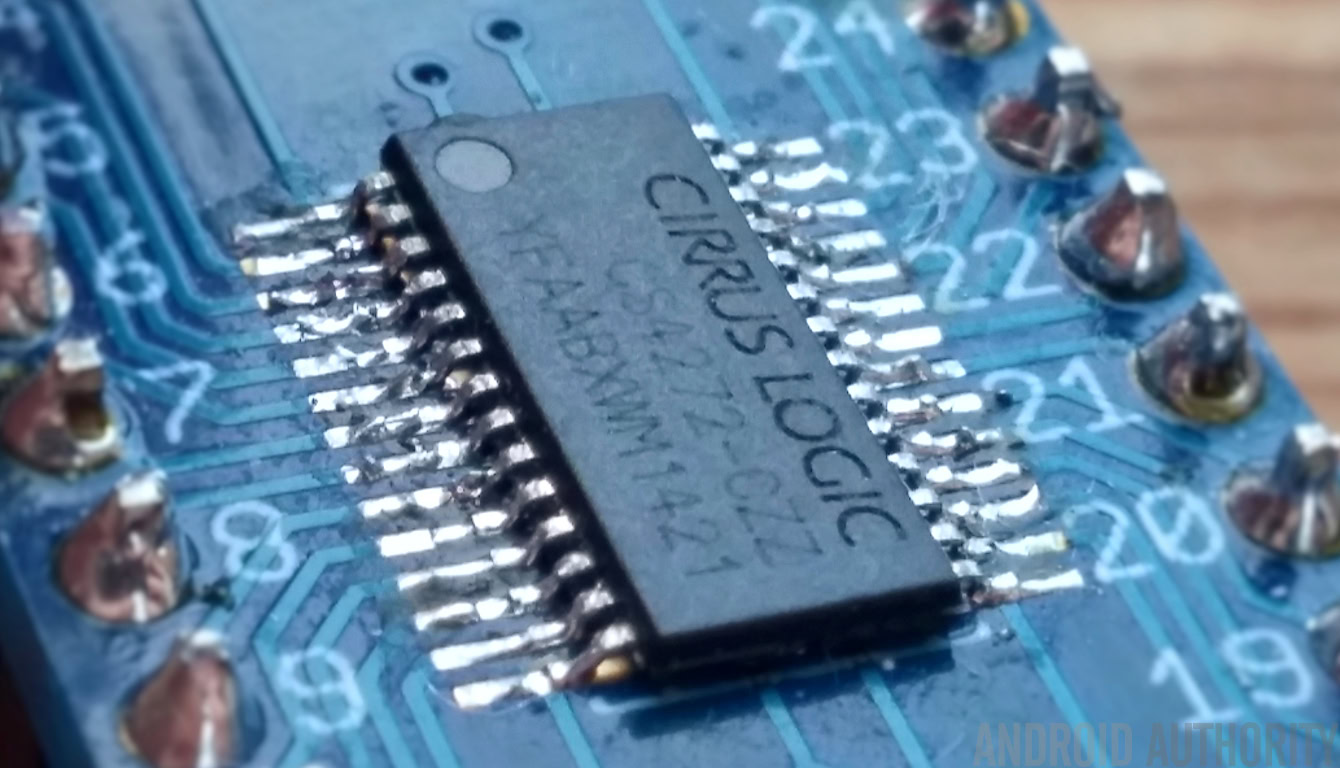
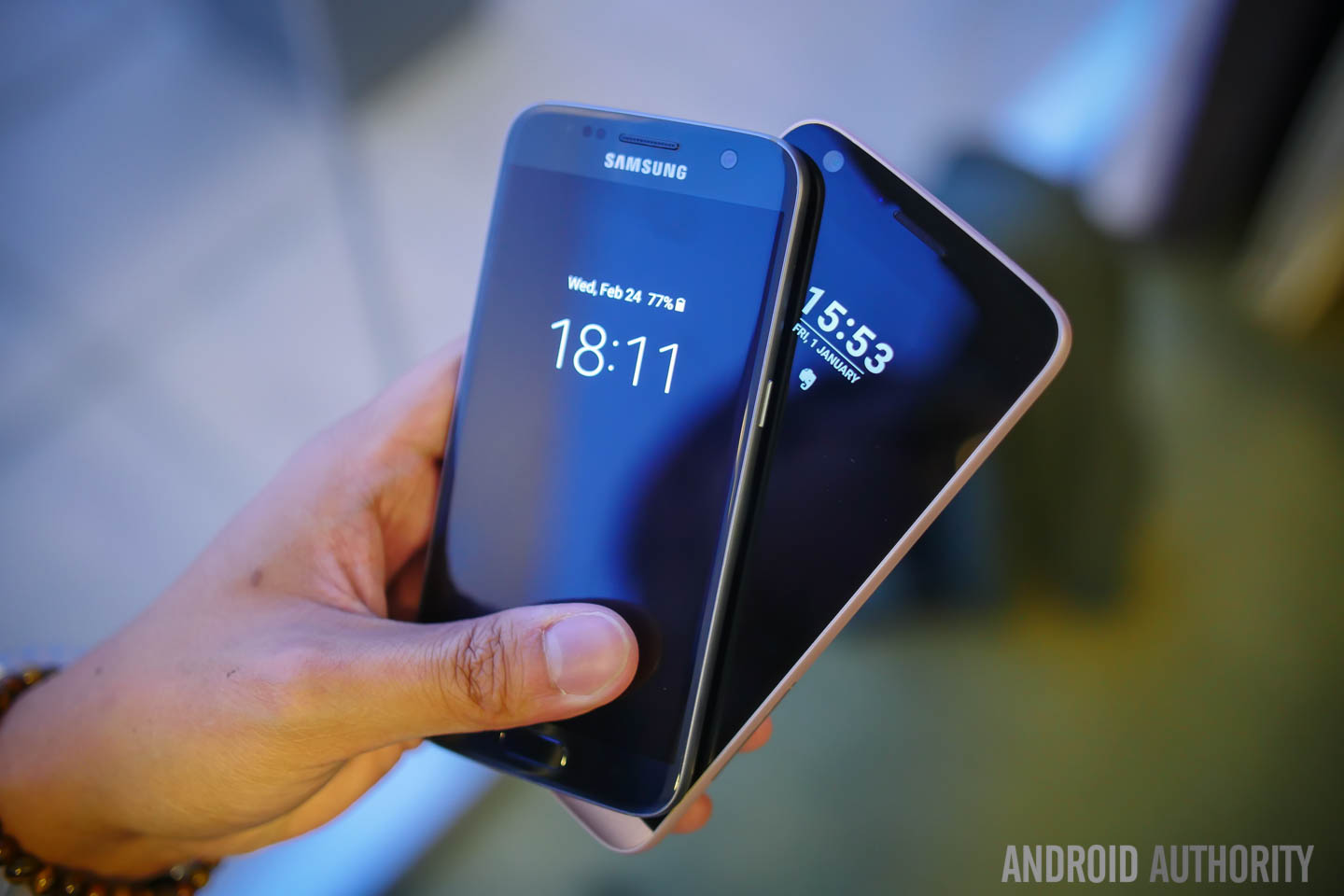
Clearly, both the G5 and Galaxy S7 offer up hardware that is again slightly above their previous generations and other handsets on the market. Particularly when it comes to processor performance and LG’s new modular design. However, it remains to be see if the camera changes will offer any major improvements and there are a lot of similar specs to last year as well, especially when it comes to memory options.
Perhaps these two announcements also reveal how LG and Samsung both view the mobile market going forward. Samsung has made improvements to its main hardware, including the SoC and camera, but remains firmly focuses around retaining its image and brand. LG had veered off in a much more drastic direction, not only changing up its core hardware but also clearly trying to build a new brand image through its wide range of accessoriess. While Samsung appears content, LG may be more rattled about the slowing hardware market and is trying hard to find interesting new avenues to explore. It will be interesting to see how other manufacturers compare later in the year.
Were do you think the LG G5 and Samsung Galaxy S7 sit in the smartphone hardware market? Are you planning to upgrade to either of them from a last generation model?